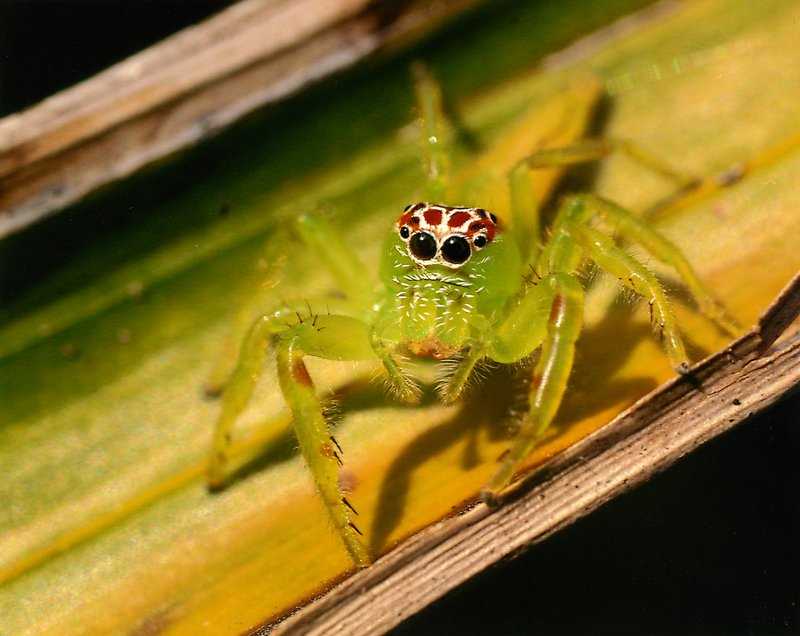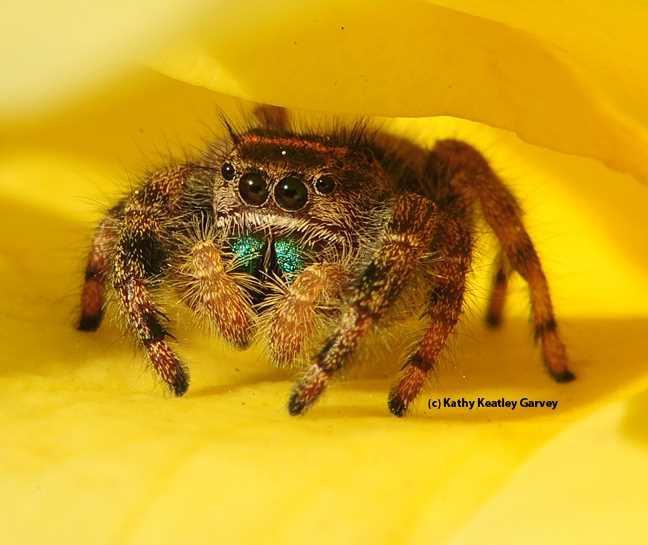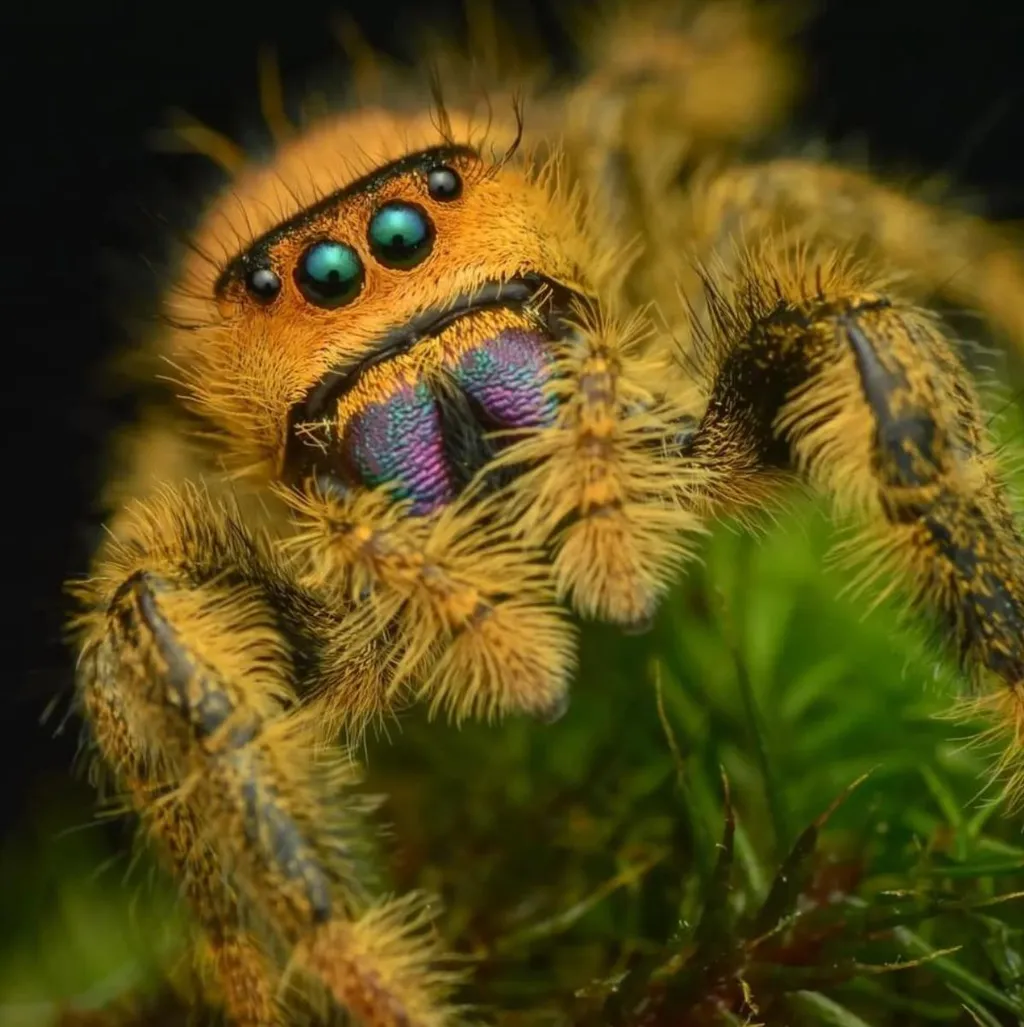
One of the most striking features of the Yellow Jumping Spider is its distinctive color. These arachnids have bright yellow bodies, which help them blend in with their surrounding environment. This coloration acts as camouflage, allowing them to ambush and capture their prey effectively. In addition to their vibrant hue, these spiders have a compact body shape with eight long and slender legs. Their legs are specially adapted for jumping, enabling them to leap impressive distances in pursuit of their next meal.
The Yellow Jumping Spider can be found in a variety of habitats, including grasslands, forests, and gardens. They prefer areas with abundant vegetation where they can easily hide and ambush their prey. These spiders create small webs for resting but do not use them to capture food. Instead, they rely on their excellent eyesight to spot and pursue their prey. With four pairs of large, forward-facing eyes, they have exceptional vision, which allows them to track their target and accurately plan their jumps.
Natural Behavior and Hunting Tactics of the Yellow Jumping Spider
The yellow jumping spider is a fascinating arachnid known for its distinctive yellow coloration and incredible jumping ability. Found in various habitats around the world, these spiders display unique hunting tactics and behaviors that set them apart from other spider species.
One of the most remarkable features of the yellow jumping spider is its incredible vision. These spiders have a set of four large forward-facing eyes that provide them with excellent depth perception and a wide field of view. Their eyes also contain specialized color receptors, allowing them to perceive the world in vibrant detail.
Using their keen eyesight, yellow jumping spiders are skilled ambush predators. They patiently wait and hide in vegetation or on tree trunks, using their camouflaged bodies to blend in with their surroundings. When an unsuspecting insect or prey comes within striking distance, the yellow jumping spider pounces with astonishing speed and accuracy.
Unlike many other spider species that rely solely on web-building to catch their prey, the yellow jumping spider uses its exceptional agility to actively hunt. With their strong and muscular legs, they stalk their prey, carefully planning their approach. When the perfect moment arrives, they meticulously calculate the distance, timing, and trajectory of their jump to ensure a successful capture.
In addition to their incredible hunting tactics and agility, yellow jumping spiders also possess impressive jumping abilities. These spiders can leap great distances relative to their size, sometimes up to 50 times their body length. Their remarkable jumping skills allow them to swiftly evade predators and efficiently capture fast-moving insects.
Overall, the natural behavior and hunting tactics of the yellow jumping spider demonstrate the remarkable adaptability and cunning intelligence of this arachnid. Their unique combination of vision, agility, and jumping abilities make them formidable predators in their respective habitats.
Unique Characteristics of the Yellow Jumping Spider
Coloration
Eyes
One of the most remarkable features of the yellow jumping spider is its large, forward-facing eyes. Unlike many other spider species that have eight eyes, the yellow jumping spider has four prominent eyes arranged in a rectangular pattern on the front of its cephalothorax. These eyes provide the spider with excellent vision and depth perception, allowing it to accurately target its prey.
Jumping Abilities
The yellow jumping spider is known for its remarkable jumping abilities. With muscular legs designed for leaping, this spider can jump many times its body length to capture its prey or escape from predators. This agile jump is facilitated by the spider’s powerful leg muscles and a unique internal hydraulic system that stores and releases energy, propelling it forward.
Predator and Insect Diet
The yellow jumping spider is a skilled predator that primarily feeds on insects. It hunts by patiently stalking its prey and then quickly pouncing on it with its formidable jumping ability. The spider injects venom into its prey to immobilize it and then uses its strong jaws to devour it.
Some of the common insects that serve as prey for the yellow jumping spider include flies, crickets, moths, and other small arthropods. Its ability to control insect populations makes the yellow jumping spider an essential component of the ecosystem.
Overall, the yellow jumping spider’s unique characteristics, such as its vibrant coloration, large eyes, jumping abilities, and predatory behavior, make it a fascinating creature worth studying and appreciating in the world of arachnids.
Preferred Habitat and Geographic Distribution of the Yellow Jumping Spider
The yellow jumping spider, known scientifically as Sitticus floricola, is a small arachnid with distinct yellow coloration and unique hunting abilities. This species can be found in various habitats across North America, including forests, meadows, gardens, and even in human-built structures.
Habitat
Unlike other spider species, the yellow jumping spider is not dependent on a specific type of habitat. They are highly adaptable and can be found in a variety of environments, including urban areas. This adaptability makes them a common sight in gardens, parks, and even inside homes. Their ability to jump great distances also enables them to explore and colonize new habitats.
Geographic Distribution
The yellow jumping spider has a wide geographic distribution range, spanning across different regions of North America. They can be found in the United States and Canada, particularly in the northeastern and central parts of the continent. In the United States, they are commonly found in states such as New York, Pennsylvania, Ohio, and Michigan.
| Characteristics | Description |
|---|---|
| Coloration | The yellow jumping spider is named for its vibrant yellow color, which allows it to blend in with its surroundings and surprise its prey. |
| Size | Adult yellow jumping spiders typically measure around 5 to 8 millimeters in length, making them relatively small compared to other spider species. |
| Eyes | This species has large, forward-facing eyes that enable them to have excellent vision and accurately judge distances when stalking their prey or avoiding predators. |
| Jumping Abilities | The yellow jumping spider is known for its remarkable jumping abilities. It can leap distances many times its own body length to quickly capture prey or escape from potential threats. |
| Legs | Like other spiders, the yellow jumping spider has eight legs. Their legs are strong and agile, allowing them to jump with precision and cling to various surfaces. |
Feeding Habits of the Yellow Jumping Spider

The yellow jumping spider, a small arachnid with distinctive yellow coloration, has a unique feeding behavior that sets it apart from other spider species. This predator primarily hunts small insects, using its exceptional jumping ability to swiftly capture its prey.
| Habitat | The yellow jumping spider can be found in various habitats, including grasslands, gardens, and forests. They prefer areas with dense vegetation, where they can easily blend in and ambush unsuspecting insects. |
| Jumping | |
| Predator | The yellow jumping spider is an opportunistic predator. It patiently waits for its potential meal and then quickly attacks when the target is within its striking range. This arachnid has excellent eyesight, thanks to its large, forward-facing eyes, which helps it accurately judge the distance and speed of its prey. |
| Feeding | Once the yellow jumping spider captures its prey, it uses its fangs to inject venom that immobilizes the victim and starts the digestion process. The venom not only paralyzes the insect but also breaks down its tissues, making it easier for the spider to consume its meal. |
| Legs and Eyes | This spider’s eight legs are equipped with specialized hairs that allow it to climb and cling to various surfaces, aiding in its hunting and mobility. Additionally, its prominent eyes provide a wide field of vision, giving it a 360-degree view of its surroundings. |
| Insect Diet | The yellow jumping spider has a diverse diet that mainly consists of insects such as flies, beetles, and ants. It relies on its agility and stealth to successfully capture its prey, making it an essential predator in controlling the population of these small insects. |
Reproduction and Mating Rituals of the Yellow Jumping Spider
Like most spiders, the yellow jumping spider follows a sexual reproduction strategy, with males and females coming together for mating. The mating behavior of the yellow jumping spider is complex and involves an elaborate courtship ritual, where the male has to perform various displays to demonstrate his fitness and attract a female mate.
Courtship Ritual
During the courtship ritual, the male yellow jumping spider utilizes its highly developed vision to locate a potential female mate. These spiders have eight eyes in total, with two large front-facing eyes that provide excellent binocular vision, enabling them to accurately judge distances and make precise movements during the courtship display.
The male yellow jumping spider approaches the female cautiously and initiates the courtship process by performing a series of intricate movements, including leg waving and body vibrations. These movements serve to attract and entice the female, displaying the male’s strength, agility, and overall fitness as a potential mate.
If the male successfully impresses the female, the courtship ritual progresses further. The male spider may then engage in a dance-like behavior, involving coordinated movements and patterned body jerks. This dance is intended to communicate intricate information to the female, indicating the male’s genetic fitness, health, and ability to provide adequate resources for successful offspring.
Copulation and Sperm Transfer

Once the female accepts the male as a suitable mate, copulation takes place. During this stage, the male will use specialized structures called pedipalps to transfer sperm to the female. The male’s pedipalps serve as secondary reproductive organs that are used exclusively for sperm transfer. It is worth noting that the pedipalps have a unique shape and structure that allows for precise delivery of sperm into the female’s reproductive organs.
The duration of copulation varies among individuals but typically lasts for several minutes. After copulation, the male will disengage from the female, and both spiders will go their separate ways.
Interaction with Other Spider Species and Predators
The yellow jumping spider, known for its vibrant yellow coloration, is a formidable predator in the arachnid world. As with other spider species, it interacts with a variety of predators, including insects, birds, and other spiders.
Predator-Prey Relationship
The primary diet of the yellow jumping spider consists of various insects. With its keen eyesight and powerful legs, it is an efficient hunter, capable of stalking and ambushing its prey. Its large, forward-facing eyes provide excellent depth perception, allowing it to accurately judge the distance and position of its prey.
When the yellow jumping spider detects an insect, it uses its powerful hind legs to pounce on its target, immobilizing it with a venomous bite. It then wraps the prey in silk, paralyzing it further and preventing its escape. Once immobilized, the spider consumes its prey at its own leisure.
Interactions with Other Spider Species
While the yellow jumping spider is a solitary creature, it may occasionally encounter other spider species, including those of its own kind. When two yellow jumping spiders meet, they engage in a “dance” to communicate and establish dominance. This ritualized display often includes displaying their vibrant colors, vibrating their bodies, and performing intricate leg movements.
Interactions with other spider species can be more hostile. When encountering a rival spider, the yellow jumping spider may engage in aggressive behavior, such as physical confrontation or attempts to intimidate. These interactions are often territorial in nature, as spiders compete for limited resources and mating opportunities.
Predation by Birds and Other Predators
However, the yellow jumping spider has evolved several defense mechanisms to increase its chances of survival. Its vivid yellow coloration serves as a warning to potential predators, indicating that it may be toxic or unpalatable. Additionally, its agility and jumping ability allow it to quickly escape from dangerous situations, utilizing its powerful legs to propel itself to safety.
| Spider Species | Predation Behavior |
|---|---|
| Yellow Jumping Spider | Predator of insects |
| Orb-weaver Spider | Predator of flying insects |
| Wolf Spider | Predator of ground-dwelling insects |
All About the Yellow Jumping Spider
The Jumping Abilities
The yellow jumping spider is named for its incredible jumping abilities. With its powerful legs, this spider can leap several times its body length, allowing it to quickly pounce on its prey. This hunting tactic gives the yellow jumping spider an advantage when catching small insects and other prey.
Predator in Action
The yellow jumping spider is an exceptional predator. Its keen eyesight, which includes four pairs of eyes, allows it to detect and track its prey with precision. Once the spider spots its target, it will patiently stalk and wait for the perfect moment to pounce. The spider’s unique vision and high agility make it a formidable hunter.
Importance in Controlling Insect Populations
The yellow jumping spider plays a significant role in regulating insect populations in its habitat. As a predator, it helps to control the numbers of various small insects such as flies, mosquitoes, and other pests. By keeping these populations in check, the yellow jumping spider helps maintain the balance of the ecosystem.
Beneficial Effects on Plants
Aside from controlling insect populations, the yellow jumping spider also has potential benefits for plants. Its diet primarily consists of insects that can be harmful to vegetation, such as aphids and caterpillars. By consuming these pests, the spider indirectly helps protect plants from damage, promoting their growth and overall health.
Diversity in the Ecosystem
The presence of the yellow jumping spider contributes to the biodiversity of the ecosystem. Its unique characteristics and behaviors add to the overall richness and complexity of the environment. The spider’s interactions with other spider species and predators also play a role in shaping the dynamics of the ecosystem.
Conservation Efforts
While the yellow jumping spider is not currently classified as endangered, it is essential to monitor and protect its habitat. Conservation efforts focusing on preserving the natural habitats where the spider thrives can help maintain its population and ensure its continued role in the ecosystem. Additionally, raising awareness about the importance of these spiders and their positive impacts can promote their conservation.
Threats and Conservation Efforts for the Yellow Jumping Spider
The yellow jumping spider, known for its vibrant coloration and unique traits, faces a range of threats in its natural habitat. One of the main threats to the yellow jumping spider is the loss and fragmentation of its habitat. As human development expands, the spider’s natural habitat, such as grasslands and meadows, is being destroyed or altered, leaving it with limited resources and suitable areas for hunting and mating.
To ensure the conservation and survival of the yellow jumping spider, several efforts have been made. One of the primary conservation efforts is the preservation and restoration of its natural habitat. Conservation organizations and researchers work to protect grasslands and meadows where the spider is found, as well as implementing habitat restoration projects to provide suitable areas for the spider to thrive.

I’m Lena Adams—a product of an unconventional upbringing in the African wilderness. My father, a daring explorer of African wildlife, sparked my fascination with reptiles, a passion that intertwined with the tragic loss of my mother during an expedition, leaving an indelible mark on my life. Driven to understand the creatures that captivated my parents, I embarked on my journey, sharing insights about reptiles, frogs, and lizards on my website. Through my explorations and conservation efforts, I honour my family’s legacy while seeking connections—to the creatures, nature, and the mother whose presence I yearn to understand.
